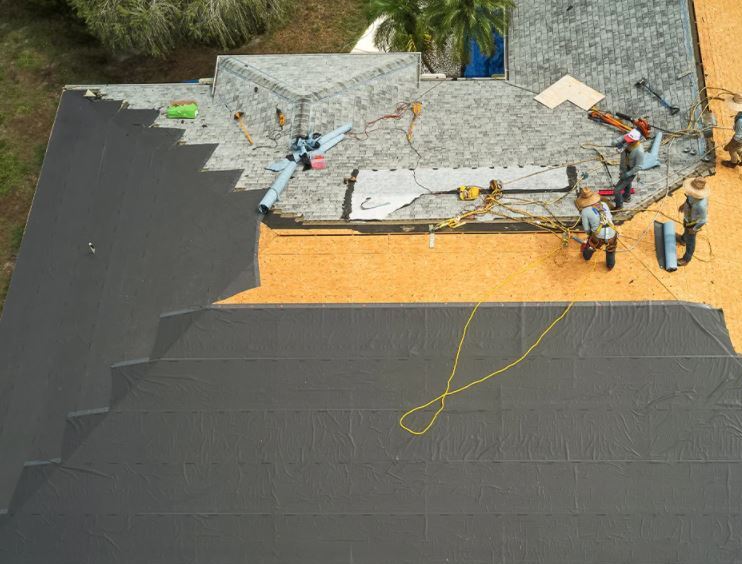From hurricanes and hail to tornadoes, roofers face unique challenges protecting storm-damaged roofs—especially during unprecedented times such as shingle supply challenges facing the entire industry.
Rather than struggling with roof tarping, move beyond the blue tarp with a longer-term solution and weather storm season safely with a premium solution like GAF Extended Dry-in Membrane.
Facing More Storms with Alternative Solutions
With the prediction of another above-normal hurricane season from the National Oceanic and Atmospheric Administration, roofers can expect increased demand for services. Higher demand could lead to more storm-damaged roofs left vulnerable for longer periods.
Jeff Avitabile, senior product manager of steep slope accessories for GAF, explains how Extended Dry-In Membrane is a superior alternative to blue tarps for roofers. It's easy to install, covered by warranty for up to 12 months when left exposed*, can help prevent callbacks, and offers long-term benefits to customers. It also qualifies as a leak barrier in GAF enhanced residential warranties, as long as an eligible GAF Roofing System is installed within one year of the membrane installation**.
Safeguarding Roofing Systems through Extended Dry-In Membrane
Use this peel-and-stick membrane when major storm-damaged structures with roof slopes of 2:12 and above are open to rain, large portions of a roofing system are blown off, or a home is left vulnerable to further leaking, storms, and damage.
"GAF Extended Dry-In Membrane isn't for a few courses of shingles," says Avitabile. "Install this when you need to protect the home until a major roof system repair or replacement can occur." The product's design maintains its integrity over time, even in the face of moisture and UV exposure.
Tackling Storms through Technology
Traditionally, a blue tarp protects homes until permanent repairs or replacement can occur.
"A blue tarp is better than nothing—but over time it may degrade. Once it degrades, wind and water can get under the tarp, and the remaining roof structure can start to degrade," explains Avitabile. "It's not a dry-in solution."
The Extended Dry-In Membrane offers enhanced wind, tear, and UV resistance versus a blue tarp. After all, it was specifically designed for roofing—tarps were not. This membrane offers:
Premium butyl adhesive that tightly bonds to most roof decks
A high-traction surface for improved contractor safety during wet and dry installation
Leak-resistant self-sealing around fasteners
A high-temperature design that can tolerate temperatures up to 270° Fahrenheit and is compatible with most metal and asphalt shingle roofing systems
The ability to be left exposed for up to 12 months
Landing on a Familiar Installation Process
The peel-and-stick underlayment features a familiar installation process, similiar to typical peel and stick underlayments that most roofers use on a daily basis. First, remove any and all damaged roofing system components and ensure a sound, dry roof deck. Then, peel, place and stick the Extended Dry-in Membrane on the roof deck. Since this product can be left exposed for extended periods of time, GAF has put together this Key Installation Details video to help contractors ensure the product is installed properly for maximium protection.
"Extended Dry-In Membrane has a robust adhesive that bonds directly with the wood deck. Even exposed to the elements, it is covered by warranty for up to 12 months*. It won't flap around in the wind or degrade," he says.
It's also a time-saver. In lieu of removing the tarp and addressing additional water damage caused by tarp leakage, contractors can install a roofing system directly over the membrane for up to one year. The product is also eligible for coverage under enhanced GAF warranties when your customers select an eligible GAF roofing system**.
Benefits for Roofers
A longer-term, dry-in solution bolsters roofers and the industry even in the face of supply challenges. "With warranty coverage, the superior bond the adhesive provides—and the resistance to UV, wind, and rain—we're creating a solution to help folks with dry-in protection until the GAF Roofing System can be installed," says Avitabile.
Stronger roof protection can also prevent callbacks that result from tarp degradation or blow-offs. This allows businesses to focus on installing roofs, not re-tarping homes, ultimately saving roofers time and money.
Benefits for Customers
Roofers aren't the only ones who benefit from improved dry-in solutions. A premium, longer-term dry-in solution offers customers greater benefits compared with alternatives like tarping. Educate homeowners to help them understand how this investment can save them money in the long run.
Some homeowner education talking points include:
Helps resist water damage until a roof repair or replacement can occur, thanks to premium adhesive and surface channels that guide away moisture
Doubles as underlayment in their future GAF roofing system
Offers warranty coverage for up to 12 months when left exposed*
- Is eligible for up to a lifetime*** limited warranty when an eligible GAF Roofing System is installed over top within one year of the installation of the GAF Extended Dry-In Membrane
Saves money by helping prevent further—potentially costly—damage to the home and roof structure
Ready to revolutionize your storm response? Contact a GAF Territory Manager today to learn more and begin using Extended Dry-In Membrane with your customers.
*See 1-Year Limited Warranty on GAF Extended Dry In Membrane for complete coverage and restrictions.
**See gaf.com/lrs for complete details on eligibility.
*** Lifetime refers to the length of warranty coverage provided and means as long as the original individual owner(s) of a single-family detached residence [or eligible second owner(s)] owns the property where the qualifying GAF products are installed. For other owners/structures, Lifetime coverage is not applicable. Lifetime coverage on accessories, such as the GAF Extended Dry-In Membrane, requires the use of any GAF Lifetime Shingle and at least 2 additional qualifying GAF Accessories. See the GAF Roofing System Limited
Warranty for complete coverage and restrictions.




